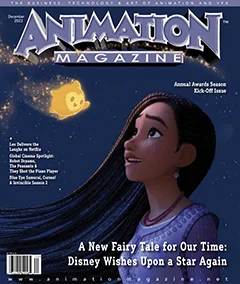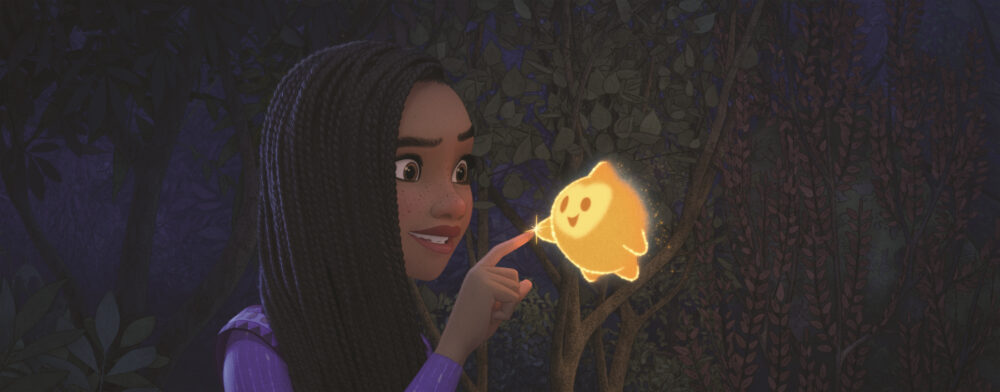|
Getting your Trinity Audio player ready...
|
No other studio in the world is more closely associated with wishes and dreams than Walt Disney Animation Studios. From the moment Cinderella sang, “A dream is a wish your heart makes, when you’re fast asleep,” audiences around the world were taken to a place where fixing your eyes on an evening star while thinking of your heart’s desire might just make it come true. So, it seems only natural that Wish, a movie about the power of aspirations, would be the film the studio would make to celebrate its 100-year legacy in 2023.
Jennifer Lee, Chief Creative Officer at Walt Disney Animation Studios and writer and co-director of Frozen and Frozen II, began developing Wish as an original story in 2018 with Disney’s 100th anniversary in mind. She wanted to tell a new story that celebrated the studio’s contemporary achievements and embraced its legacy. Lee quickly brought on her longtime collaborator, Chris Buck, who co-directed Frozen, Frozen II and Frozen Fever with Lee and co-directed Tarzan and Surf’s Up earlier in his career. As the two of them looked at scenes from Disney classics, they quickly saw the act of wishing and wishing stars themselves as a throughline in the studio’s history.

Buck and Fawn Veerasunthorn (head of story on Raya and the Last Dragon and story artist on Zootopia and Ralph Breaks the Internet) co-directed the film. This marks Veerasunthorn’s first time as a director. After five years in production at the Burbank studio with a crew of about 500, the film will be released November 22.
Wish also features a powerhouse voice cast of Ariana DeBose (Asha), Chris Pine (King Magnifico), Angelique Cabral (Queen Amaya), Victor Garber (Sabino, Asha’s grandfather), Natasha Rothwell (Sakina, Asha’s mother), Jennifer Kumiyama (Dahlia, Asha’s best friend), Harvey Guillén (Gabo), Niko Vargas (Hal), Evan Peters (Simon), Ramy Youssef (Safi), Jon Rudnitsky (Dario) and Della Saba (Bazeema).
Agent of Change

The story follows Asha, an idealistic young woman living in the Kingdom of Rosas (located off the Iberian Peninsula) who is not quite sure of which path she wants to take in life. She tries to become the apprentice of a wish-granting wizard named King Magnifico, but gets a glimpse behind his magical abilities and starts to see things she doesn’t like. From there, she must reimagine how she’ll go forward in her life, and she does so with a little help from a magical character named Star.
“Asha is learning about who she is and what she really wants in life,” says Lee. “At the beginning of the story, she doesn’t really have her wish in mind. She thinks that by following Magnifico, and learning from him, she can find her path. So, this is a story about her finding her wish and her voice.”

Just as the filmmakers wanted a story invested in Disney’s tradition of wishing, they also aimed to give the film a look that reflected the history of animation at the studio. For inspiration, they turned to studio archives and looked at concept art created over many decades. They imagined a hand-drawn look that would translate into a kind of moving illustration for Wish.
“We wanted that look that takes you back a bit to the films that you’ve seen in the past from Disney that are maybe part of your childhood, part of the first animated films you loved,” says Buck. “We’re working in CG but [are] definitely inspired by the hand-drawn history of this place and the emotions you have when you see something hand-drawn.”
As production designer Lisa Keane explains, “There’s a watercolor look and a paper texture — it’s a moving illustration. We’ve long had the ability to do watercolor backgrounds, but we couldn’t quite achieve the same look on the character. We are now able to marry all those ideas in CG because of the tools that have been developed. It was exciting to watch it all come together.”
Since the film production started before COVID shutdowns, the filmmakers were at home for part of the production time. Coming back to the studio later in the process meant they were able to work together more easily again.

Made for the Big Screen
“For me, working on this film — it was a time where we just started to come back from being on Zoom,” says Veerasunthorn. “We were able to be together to see and review scenes from the movie in the theater with the big screen. I think that’s what led to the decision to use the 2.55:1 aspect ratio because we understand the importance of being immersed in a film, not just on your monitor or your TV. So, there are a lot of choices we made in how we frame this movie [and] how we use the technology of 3D stereo. We put a lot of emphasis on that. We want the audience to see this big, in a theater.”
The film’s VFX supervisor, Kyle Odermatt, who has also worked on Raya and the Last Dragon and Moana, adds, “This aspect ratio is part of our tradition, which harkens back to some of our classics. It’s something we wanted to do, and what we’re trying to do is have this feeling that pays tribute to our legacy. We also really wanted to control our camera and composition in ways that made sense for the story. That’s always part of developing the cinematography plan.”
‘We’re working in CG but [are] definitely inspired by the hand-drawn history of this place and the emotions you have when you see something hand-drawn.’
— Director Chris Buck

Odermatt and his team also worked to bring the filmmakers’ vision of moving illustrations to life. The process was challenging since the look they wanted hadn’t been created yet.
“We created [a texture that looks like watercolor on paper]” says Odermatt. “It works great on something that’s still, but it’s a very challenging thing to do with moving imagery, because it’s very likely that that pattern stays static. The innovation we came up with to create this look is called dynamic screen space texturing.”
Memorable Melodies
In true Disney tradition, songs play an essential role in the storytelling of Wish. Lee wanted to find a songwriter who could give the film the kind of timeless songs that would become standards in the studio’s catalog. Julia Michaels and Benjamin Rice became their go-to team. Michaels, who has written songs for Dua Lipa, Pink and Selena Gomez, among others, and Rice crafted seven original songs for the film. (Leading up to the film’s opening, Disney has released videos for two of the tunes, Asha’s “This Wish” and Magnifico’s “This Is the Thanks I Get?!”)
“Julia Michaels is an extraordinary talent, and Julia, along with her writing partner Benjamin Rice, have created original songs that inspired all of us working on the film,” says Lee. “Her collaborative process was so special, really sitting down with us and talking about the motivations of our characters.”
‘We worked with cultural consultants on the clothing to represent what the fashion of the time might be to ensure the crossing of cultural influences that took place in the region during the Middle Ages was well represented.’
— Director Dawn Veerasunthorn


Veerasunthorn found the idea of wishes and dreams very powerful and wants the people who see Wish to see themselves in the characters.
“To me, it’s kind of rooted in the songs that are in the movie,” says Veerasunthorn. “The notion that there’s a power within you to wish and to dream and that’s something that’s yours. My hope is that people feel that when they see this movie that they recognize what’s within them. I hope that they know they can always be active and take action, and even if you’re going to fail at something that you’re not going to fail overall because life is richer and better when you follow your dreams.”
For Buck, it’s also about dreams: “In my mind is that someone in the audience, who is perhaps an older person, someone who has either forgotten their dream or given up on their dream, or life got in the way, and they put their dream on hold. I hope they decide they’re just going to do it because it’s their passion and that’s what they’ve always wanted to do, and why not now?”
Disney’s Wish opens in theaters nationwide on November 22, following early access screenings on November 18.

 Introducing a Cosmic Ball of Energy!
Introducing a Cosmic Ball of Energy!
At the center of Walt Disney Animation’s Wish is a character who carries the legacy of just about every animated film to come out of the studio. That character is Star, who glides through scenes leaving a little pixie dust here and there.
“The first part of Wish coming together was when Jen [Lee] had whispered in my ear after Frozen II that it was 2018, and 2023, which would be the 100th anniversary of the studio, is coming up,” says Wish co-director Chris Buck. “She asked if I wanted to be involved with a film that would celebrate that history. And the genesis of the idea started with just pinning up a scene from each animated film on one bulletin board, and then looking at the whole sort of legacy of our studio. That led us to the wishing star because we’ve had so many characters wishing on stars, so it seemed like this was our DNA and what should be guiding us is this idea of wishing on a star.”
In the spirit of celebrating the history of the studio, Star was initially drawn by hand. They then placed Star next to the main character, Asha. They wanted Star to look a certain way in each scene — it had to make sense next to the other characters and be magical, with a trail of pixie dust. After careful thinking and scheduling, they came up with a plan.
“We knew that [it] was going to be difficult to do hand-drawn animation of Star over an entire film with the schedule we had, so we decided on CG done in a style that was inspired by hand-drawn,” says Buck. “We were inspired by the hand-drawn tests, and we found it fits the world that the other characters live in and has the dimension of the same world.”
According to Buck, the filmmakers wanted to convey the energy, hope and light in the simplest and purest way. “We also decided that Star shouldn’t talk — it’s so much more effective as a pantomime character. This is something that Disney has done so well throughout its history. Audiences fall in love with these visual characters — they can give them their own voice. We all need a little Star in our life.”













 Win a Funko X Lilo & Stitch Prize Pack!
Win a Funko X Lilo & Stitch Prize Pack!

